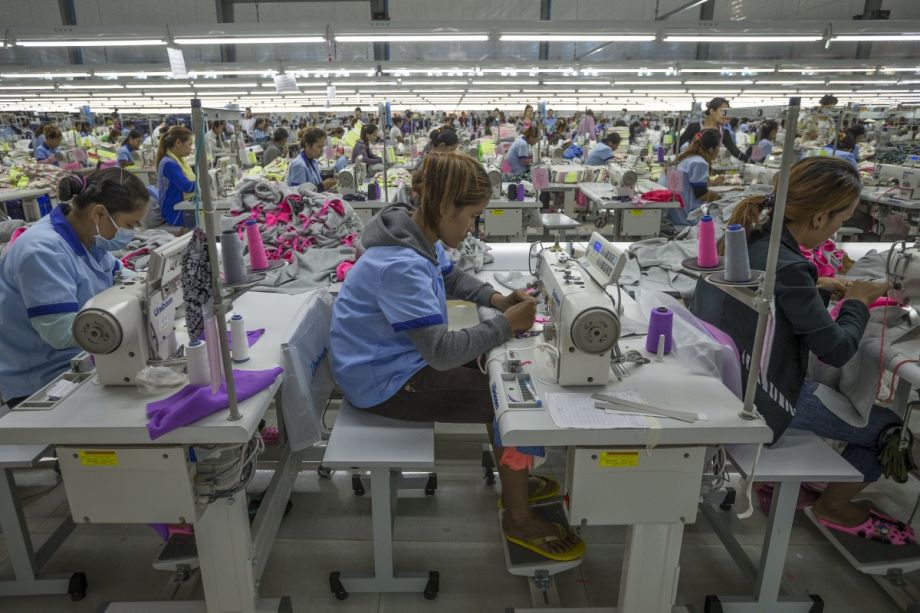At the end of December, 22-year-old garment worker Sen Peak stood on the street outside the Ministry of Labor in Phnom Penh with more than 1,000 other tired-looking women covered in dust kicked up by a sea of bodies and a cacophony of motorbikes.
“We can’t live on so little,” said Peak, a slight woman with a set of pronounced cheekbones that arch against her skin like two commas.
Peak is among approximately 600,000 Cambodian garment workers living on a minimum monthly wage of $75, plus a $5 health bonus. The rate is slightly better than the $61 minimum wage she earned last year, but the unions that represent her industry are fighting for more.
The striking workers, who noisily blocked Russian Federation Boulevard, a primary artery leading to the city on which the Labor Ministry stands, were met by a battalion of police in riot gear, who squared up with the crowd at a menacing proximity. Soldiers toying with unsheathed guns switched between staring directly at us and then straight through us.
Peak told me that inside the Ministry, labor unions and industry officials were warring over her monthly wage, the unions demanding it be doubled to $160 in 2014. Earlier that morning, a large group of demonstrators en route to the city’s Freedom Park, a designated free-speech zone, tried marching inside the Phnom Penh Special Economic Zone, an area brimming with garment factories on the outskirts of the capital. Police forces beat them back with electrified batons, according to Hui Pischovann of the Community Legal Education Center, who said that at least one man was hospitalized for his injuries. That was on Friday, December 27.
Three days prior, labor unions had declared a nationwide strike after balking at the Labor Ministry’s decision to set 2014’s minimum monthly wage at $95. Labor Minister Ith Sam Heng later raised the garment industry’s 2014 floor wage to $100, which labor unions also rebuffed. And less than a week after Peak spoke with me, pro-government troops opened fire on striking workers, killing at least four people and injuring dozens more. Local rights organization Licadho called the brutality on January 3, “The worst state violence to hit civilians in 15 years.”
The garment sector accounts for more than 80 percent of Cambodia’s exports. Close to 90 percent of the workers are women, who are typically supporting multiple people with their minuscule salaries. Jill Tucker, chief technical advisor to the International Labor Organization’s industry-monitoring program Better Factories Cambodia, says that workers are already seeing their wage increase sucked dry by inflation and landlords who advantageously gouge their rent.
“Based on discussions with workers last week and what everyone has been telling us, increases to the cost of living in Cambodia are rising, and some of the few places where garment workers can cut back is in health care and food,” says Tucker.
If some kind of resolution isn’t reached in the near future, manufacturers will seek out locations with lower prices – places like Bangladesh, Vietnam, Indonesia and, at some point down the road, Myanmar, says Tucker.
That could create an economic crisis in a place so reliant on a single industry, adds Dave Welsh, country coordinator for Washington DC-based labor rights group Solidarity Center.
“Losing the garment sector would be disastrous for this country. The industry pulls 500 billion dollars from roughly 500 factories,” says Welsh, noting that in a nation where workers’ ability to collectively bargain is skewed to benefit their employers and corruption frequently cancels out the tenets of the country’s labor law, industrial strikes are nearly impossible to avoid.
Last year, The Garment Manufacturers Association in Cambodia (GMAC) recorded 131 strikes, excluding the nationwide strike beginning last year. In 2011, the factory association only recorded 34 strikes for the entire year.
The uptick in protests has arguably been exacerbated by the political climate, which rose to a boil in July, when Prime Minister Hun Sen’s Cambodian People’s Party lost a sizable chunk of parliamentary seats during the national elections. The opposition Cambodia National Rescue Party nearly doubled its number of seats, effectively threatening Hun Sen’s nearly 30-year reign.
Thousands of voters took to the streets demanding a reelection; Buddhist monks abandoned political neutrality, ignoring politicians and Abbots’ calls to remain uninvolved. In the months leading up to 2014, bewildered tourists flocked to Phnom Penh during the country’s cool season, snapping pictures of the growing number of heavily armed authorities lining the city’s streets.
When the garment workers aligned with the opposition party in December and began demonstrating in even larger numbers, everything changed. The credibility of the ruling party wasn’t the only thing on shaky ground anymore; the country’s linchpin industry was losing millions of dollars in profits.
“The garment workers won’t stay quiet any longer,” says Moeun Tola, head of the Phnom Penh-based Community Legal Education Center. “If this continues, the Cambodian economy will not just lose more [money] than it already has, but workers will continue calling on leaders, regardless of political party [affiliation] to hold themselves accountable.”
On January 7, Van Sou Ieng, president of the GMAC said that factories lost $300 million in profits and an additional $70 million invested in production since the walk out, according to the Phnom Penh Post.
In the aftermath of the shootings on January 3, mere days after protestors ran from flying bullets spewing from guns paid for by their government, a friend returned from the scene intact with a memento of the violence resting in his pocket. A shell casing now rests on his desk in memory of the men killed on January 3.





_1200_700_s_c1_600_350_80_s_c1.jpg)








